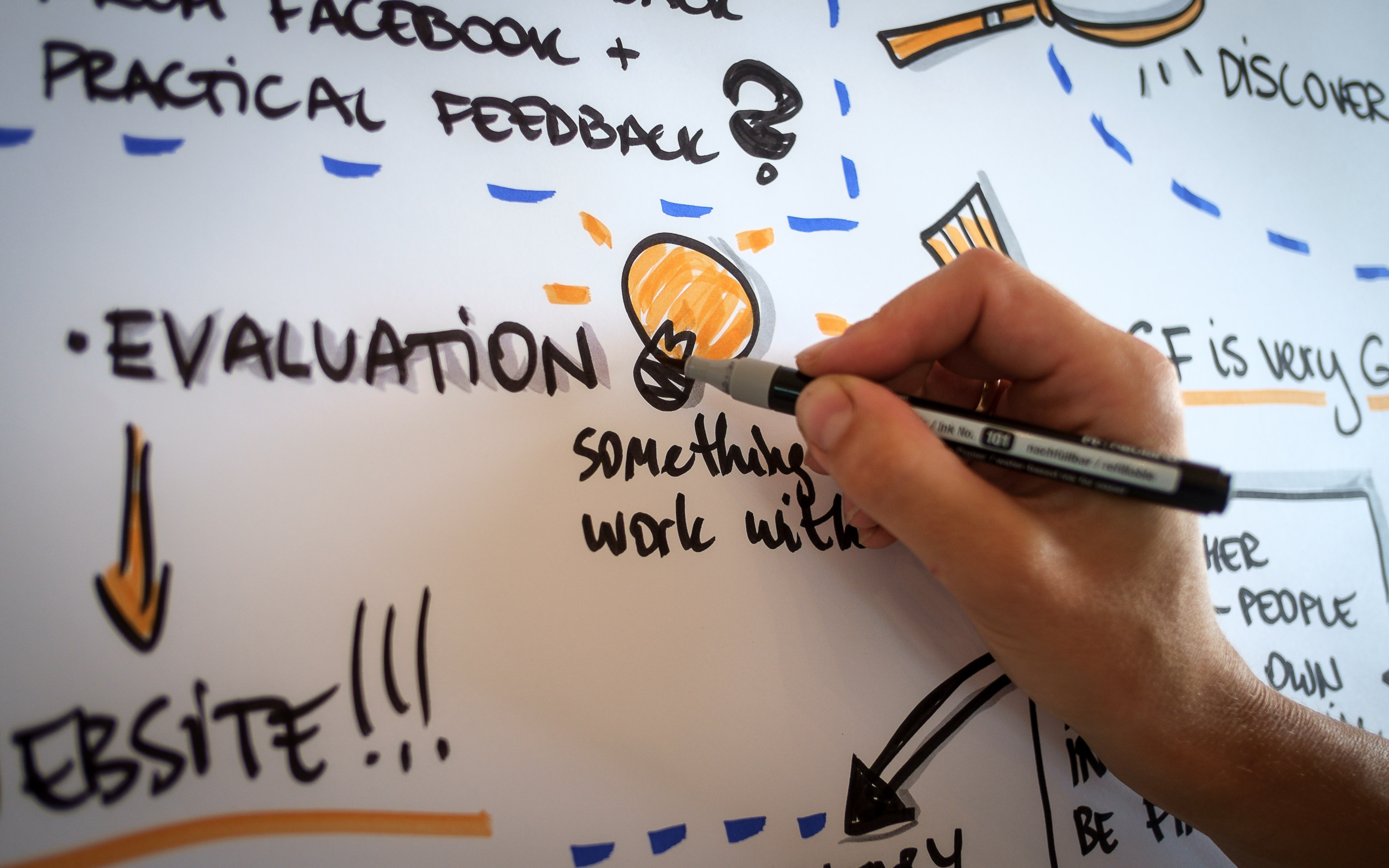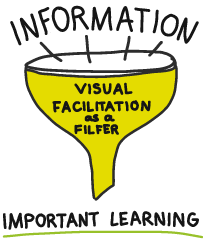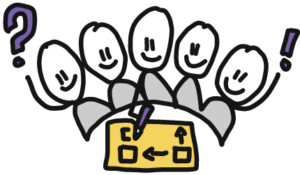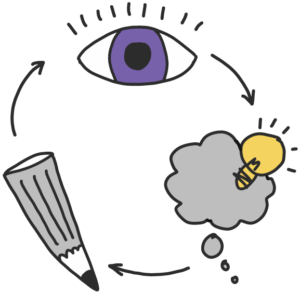

 The pencil and paper are powerful thinking, learning, and planning tools that take us closer to the desired goal. By using our innate ability to see both with our eyes and imagination and resorting to simple drawing, it gives us a whole new way to discover hidden ideas, develop them intuitively and share with others in such a way that they understand. Although both imagination and scribbling are our innate abilities, we do not make them work for our advantage as grown-ups (and sadly already also in school). We either do not dare to do so or are convinced that we cannot scribble, consider it too time-consuming, or think that drawing is for small children.
The pencil and paper are powerful thinking, learning, and planning tools that take us closer to the desired goal. By using our innate ability to see both with our eyes and imagination and resorting to simple drawing, it gives us a whole new way to discover hidden ideas, develop them intuitively and share with others in such a way that they understand. Although both imagination and scribbling are our innate abilities, we do not make them work for our advantage as grown-ups (and sadly already also in school). We either do not dare to do so or are convinced that we cannot scribble, consider it too time-consuming, or think that drawing is for small children.
Thinking with a pencil has many different names. Good children have multiple names after all. You might find names, such as visualisation, visual thinking, visual or graphic simplification, visual or graphic recording, but their essence remains the same. It includes making any verbal text – be it either your thoughts inside your head or information and knowledge that you hear/read/speak of – visible. Visual simplification is like a filter that allows to distinguish the important from the unimportant and to make complex things simpler.
Putting things down on paper allows us to see the associations and the whole picture more easily, we are more creative and more efficient thinkers. This, in turn, makes us better listeners, learners, speakers, performers, partners, and leaders.
 You tell your colleagues about a new idea with enthusiasm. Your eyes glow, your hands gesticulate, the words flow out of you. However, it seems that no one understands what you are talking about and the questions start piling in: “What is the result?”, “What does it have to with today?”, “How shall we do it?”, “What is my role?”, “I don’t really understand…?” etc. Eventually, you grab a paper and a pencil and draw a quick sketch of your idea. Some boxes, some arrows, a few keywords. And suddenly there is clarity because they can see your idea and what you are talking about. They start contributing their ideas and in the best scenario, this diagram leads to new, progressive questions.
You tell your colleagues about a new idea with enthusiasm. Your eyes glow, your hands gesticulate, the words flow out of you. However, it seems that no one understands what you are talking about and the questions start piling in: “What is the result?”, “What does it have to with today?”, “How shall we do it?”, “What is my role?”, “I don’t really understand…?” etc. Eventually, you grab a paper and a pencil and draw a quick sketch of your idea. Some boxes, some arrows, a few keywords. And suddenly there is clarity because they can see your idea and what you are talking about. They start contributing their ideas and in the best scenario, this diagram leads to new, progressive questions.
SIMPLE AND CLARIFYING SCRIBBLING SHOULD NOT BE THE LAST STRAW THAT WE HOLD ON TO BUT ONE OF THE FIRST TOOLS FOR MORE EFFICIENT CO-OPERATION!
 Every day, you have very many obligations and loads of things to remember. Sometimes it feels that your head is about to explode and you don’t know where to start. And then a good friend reminds you that you should put things down on paper. You do it. Suddenly, a lightness arrives, you have some more breathing space, even physically. Your head clears up. This is how it is. You do know the saying that your head is not a rubbish bin. In our daily activities, it is the short-term memory that we use and where we put our ongoing issues. However, the short-term memory has a limited volume and thus it cannot receive things endlessly. Try and imagine now that your short-term memory is full of a to-do list. How could there possibly be any space to start planning actually doing those things?
Every day, you have very many obligations and loads of things to remember. Sometimes it feels that your head is about to explode and you don’t know where to start. And then a good friend reminds you that you should put things down on paper. You do it. Suddenly, a lightness arrives, you have some more breathing space, even physically. Your head clears up. This is how it is. You do know the saying that your head is not a rubbish bin. In our daily activities, it is the short-term memory that we use and where we put our ongoing issues. However, the short-term memory has a limited volume and thus it cannot receive things endlessly. Try and imagine now that your short-term memory is full of a to-do list. How could there possibly be any space to start planning actually doing those things?
PUTTING THINGS DOWN ON PAPER HELPS TO KEEP THE SHORT-TERM MEMORY CLEAN AND THIS, IN TURN, BRINGS MORE LIGHTNESS INTO OUR DAILY LIFE AS WELL AS MORE EFFICIENT ACTIONS!
 Once we set ourselves a goal, we usually also plan the steps that take us towards it. If lucky, we also think about the starting position, more rarely we think of the values, possibilities, and dangers. But thinking on its own is not enough. It is easy to dream, much harder to fulfill the dream. It is so easy to dream because we can imagine it. What if we put the entire journey on paper as well? We shall literally put our dream in front of our eyes to see the connections, feel the movement, and notice the progress. People have been long drawn to maps: geographical maps and town maps to go from point A to point B. Reaching your goal is also going from one point to another.
Once we set ourselves a goal, we usually also plan the steps that take us towards it. If lucky, we also think about the starting position, more rarely we think of the values, possibilities, and dangers. But thinking on its own is not enough. It is easy to dream, much harder to fulfill the dream. It is so easy to dream because we can imagine it. What if we put the entire journey on paper as well? We shall literally put our dream in front of our eyes to see the connections, feel the movement, and notice the progress. People have been long drawn to maps: geographical maps and town maps to go from point A to point B. Reaching your goal is also going from one point to another.
THERE IS A LOT OF TRUTH IN THE SAYING: “PUT YOUR DREAMS DOWN ON PAPER AND YOU SHALL BE HALFWAY THERE ALREADY”. CREATING AN IMAGE OF YOUR GOALS HELPS TO SEE THE WHOLE PICTURE AND ASSOCIATIONS AND IT ALSO MAKES YOU ACT!
For visual thinking, you do not need much else than a piece of paper and a pencil (or an ink pen, blackboard and chalk, flipchart and a felt pen, digital board, tablet, etc.), the need to create the big picture, and the content. And this big picture will be ready to be born. It all starts with the desire to do things differently, to think outside the box, to be brave! Once you have drawn the first line on the paper, the second and the third shall also appear. Yes, it does require some courage and initiative because most of us think that we cannot draw. Actually, drawing does not play such a big role in it as thought: simply frame the texts, create a structure, show the connections and the whole picture. Once you start using this technique actively, you shall discover that it makes you give a sense to the processes around you more deeply.
If you wish, continue reading and you shall be even more assured about the importance of visual thinking and simplification!
 Visualisation comes from an ancient time as our ancestors already made visual notes in the form of cave drawings.
Visualisation comes from an ancient time as our ancestors already made visual notes in the form of cave drawings.
If you think you cannot draw, then most people would say: "Welcome to the club!"
Possibly, the only demographic group of people who really know that they can draw are currently in the kindergarten. But we have all been to the kindergarten, haven’t we? Or we have at least all been children who learned how to express themselves through drawings before learning to read or write. Therefore, it is certain that we are all very good visual thinkers. Thus, we should know how to solve any problems with the help of pictures and visualisation.
Dan Roam, author of the international bestseller “The Back of the Napkin: Solving Problems and Selling Ideas with Pictures” claims that the future key of solving business problems shall be visual thinking.
Any leader, initiator, or performer wants their thoughts to reach the audience and their ideas to be clear. When initiating new projects or going through changes, we want to encourage our teammates and want everyone to be involved in the process and work for a common goal.
American leadership philosopher, Margaret Wheatley has said that the most powerful tool that initiates crucial changes is conversation. The deeper the conversation, the more unity. The more superficial the conversation, the more conflicts. Conversation means action. Conversations create space to shape and change ideas and action. Therefore, a good leader must have the skill to create a free and open environment for dialogue, in which truly meaningful conversations happen. A meaningful conversation can be viewed as a process, in the centre of which is an important topic or question that connects the people. A conversation starts with the people, who are talking, arriving and tuning them into the talk. A mutual understanding is created: why this conversation is happening and what result is desired. Then, it is possible to listen to the perspectives and thoughts of different parties. It is essential to make conclusions and summaries of the conversation. A constructive conversation ends with agreeing on the next steps and thanking the others.
The prerequisite of a good conversation is creating a safe atmosphere, the desire and wish to listen, and the readiness to share your thoughts and ideas openly. In the present day, there is less and less time for meaningful conversations. We are exhausted by information overflow and solving the problems seems to become ever more difficult. This is why businessmen all over the world have started to improve their visual abilities in addition to conversational skills. They have realised that visualisation produces efficient dialogue and can solve any problem.
Well, if a solution is not reached, then at least visualising the problem gives a good overview of the kind of “trouble” you are in.